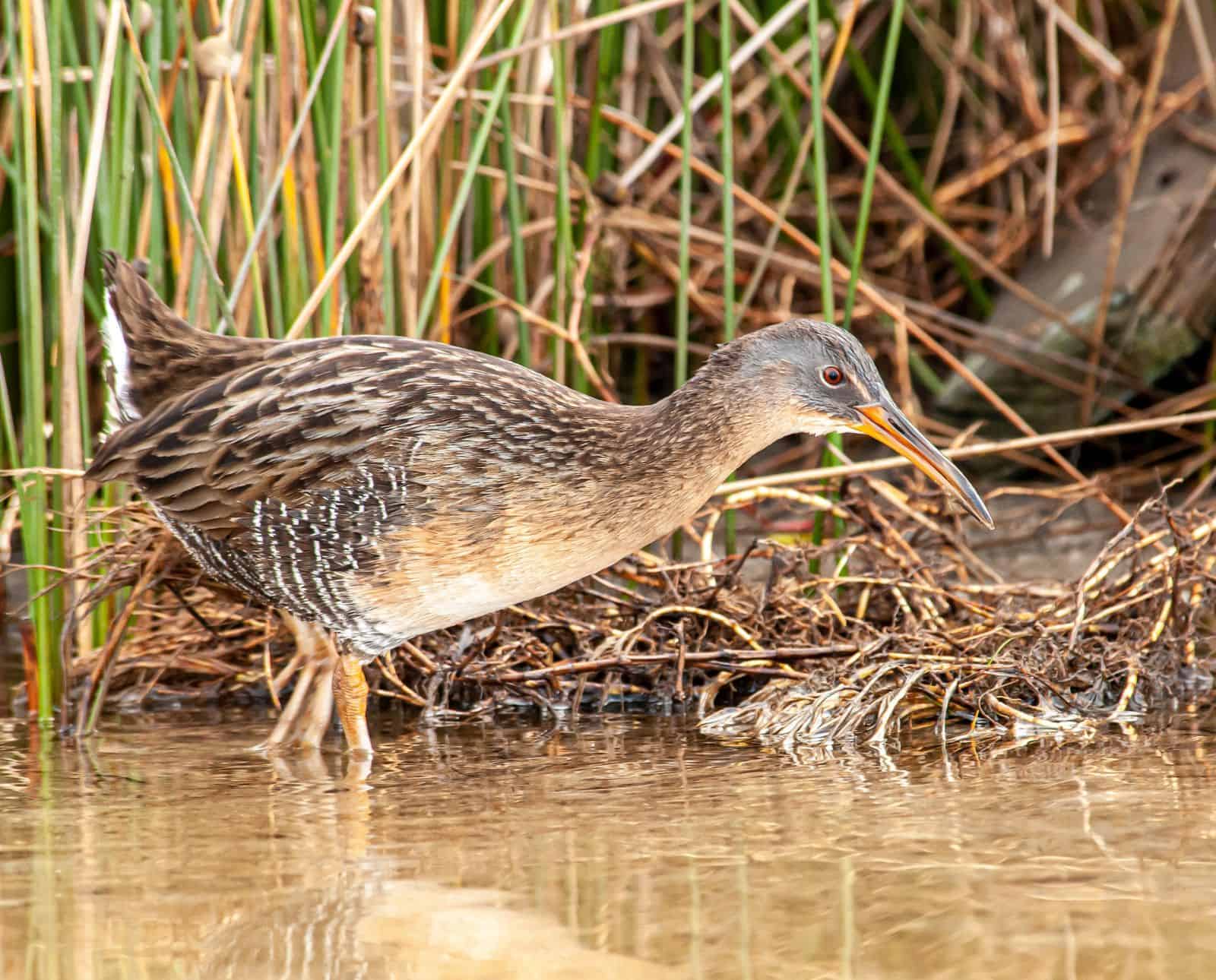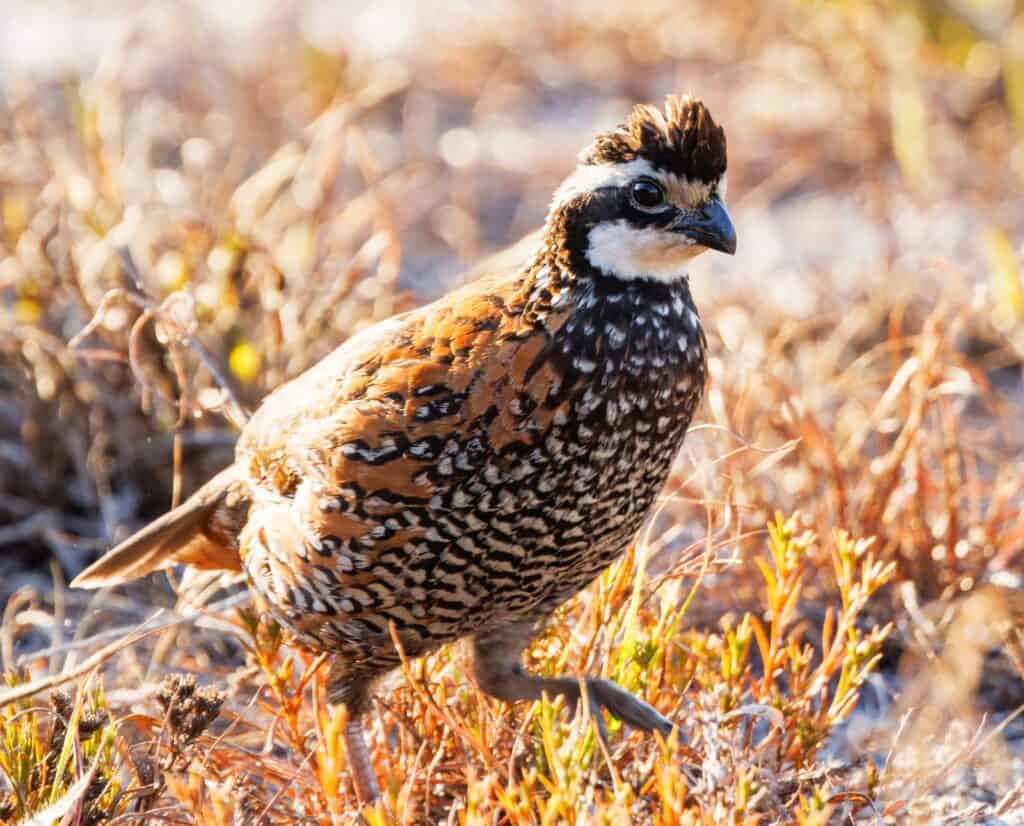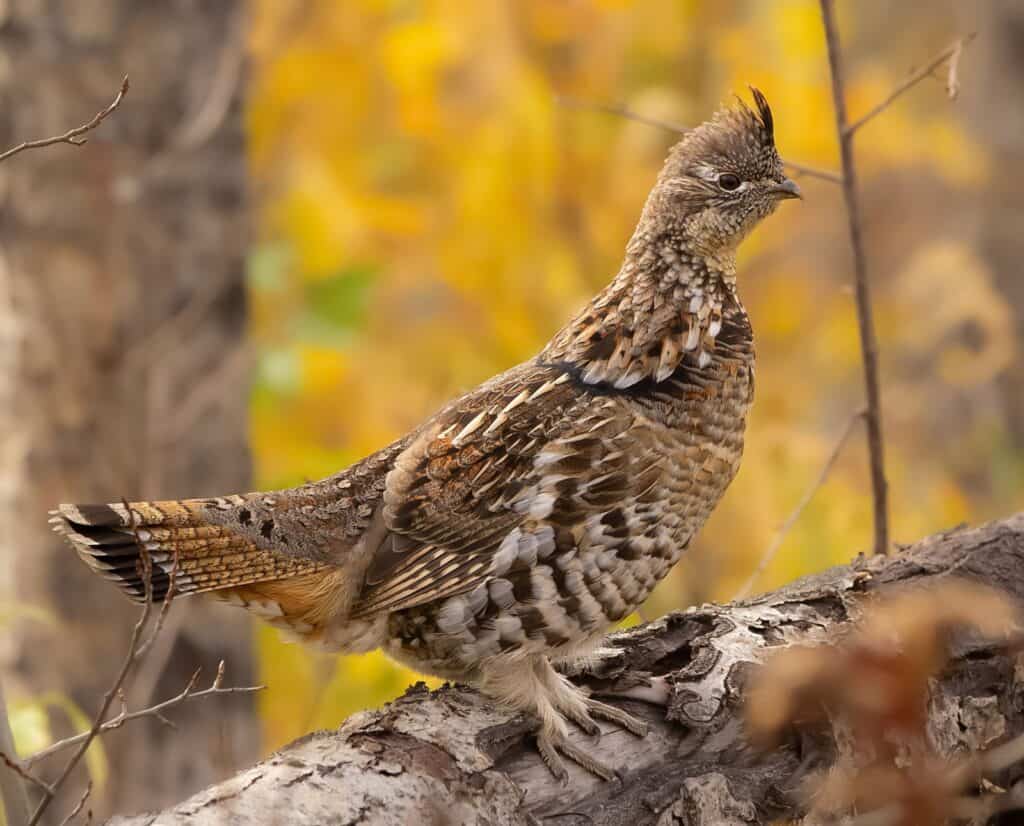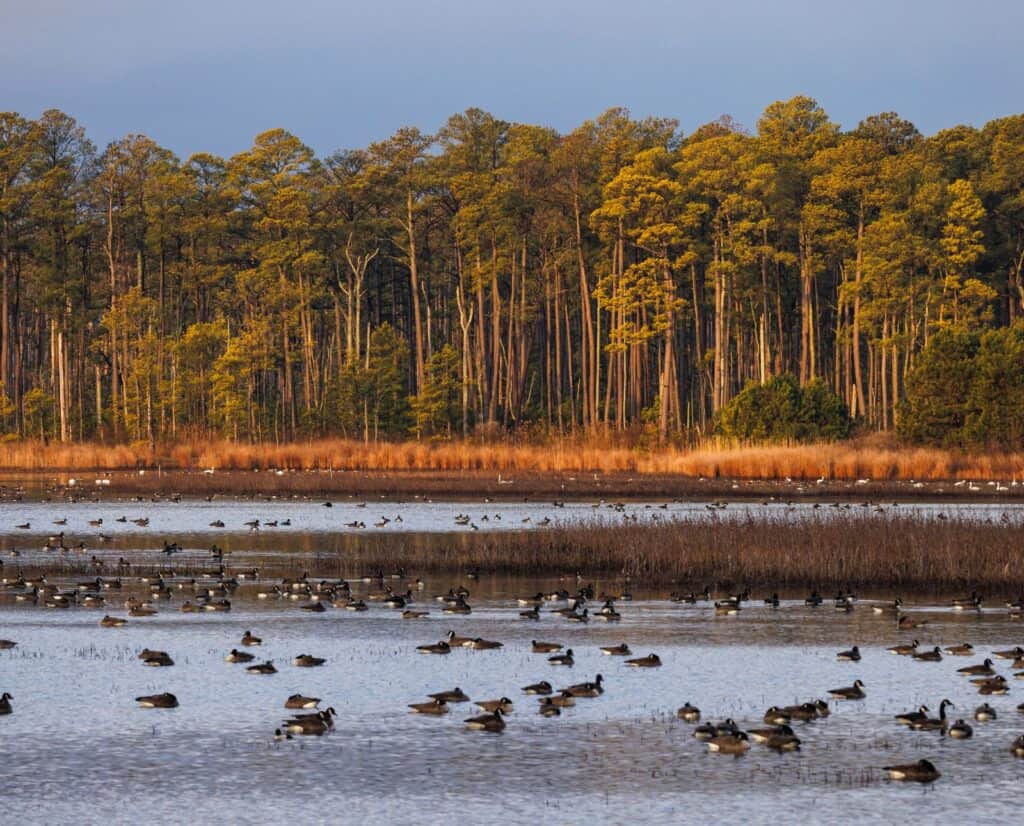Home » Hunting Rules, Licenses, and Seasons » Upland Bird Hunting in Maryland: Regulations, Bag Limits, Fees, and More
Upland Bird Hunting in Maryland: Regulations, Bag Limits, Fees, and More

Gabby Zaldumbide is Project Upland's Editor in Chief. Gabby was…
From the Appalachian Mountains to the Chesapeake Bay, hunters can chase grouse, quail, rails, and other small game in the Old Line State.
If you’ve ever had the pleasure of driving across Maryland, you’ve likely noticed the wide variety of habitat types found throughout the state. In the west, dense hardwood forests cover the foothills of the Appalachians and are interspersed with farmlands and rural communities. In the east, tall pine forests edge the brackish waters that feed into the Atlantic Ocean, spanning 7,700 miles of shoreline. It’s easy to imagine just how much bird hunting Maryland can offer.
Although most bird hunters in Maryland pursue waterfowl, the state still provides opportunities for upland bird hunting. However, populations of ruffed grouse, pheasant, and bobwhite quail have drastically declined over the past several decades. That said, conservation organizations and the Maryland Department of Natural Resources (DNR) have made considerable efforts to restore wild bird populations—especially bobwhite quail.
Before we dive into upland bird hunting regulations in Maryland, I’d first like to highlight the work being done by the DNR and Quail Forever to help bolster bobwhite populations in the state.
Bobwhite Quail Restoration Efforts in Maryland
In June, the Maryland Quail Forever Chesapeake Bay Chapter donated $50,000 for bobwhite quail conservation on public lands. Those funds were matched by $150,000 in Pittman–Robertson funds.
“To date, the chapter’s dedication has paved the way for the successful conversion of an impressive 271 acres, with an additional 196 acres set to be planted in the following year,” said Allison Menefee, the Quail Forever (QF) state coordinator for Virginia, Maryland, and Delaware, in a QF blog post.
“We’re fighting to reverse the decline, and our members are about conservation first,” said John Brader, president of the Chesapeake Bay QF chapter, in the same article. “This project is a perfect example of that mission in action. Together with the Maryland DNR, we’re building habitat that benefits quail and countless other species.”
Similar work on another piece of public land saw an existing quail population quadruple post-treatment. “Many landowners that have not seen quail recently may feel the need to release pen-raised quail, or they think habitat restoration will be a waste of time,” said Bob Long, wild turkey and upland game bird project manager for the Maryland DNR. “But in some cases, there are still a few birds present on the landscape that are just waiting for the opportunity to take advantage of the newly created habitat.”
According to the DNR, Maryland’s quail population has declined by more than 90 percent since the 1950s due to increased predation and changes in farming practices. However, land managers are using a variety of treatments to help bring bobwhite back. Practices like thinning forests, planting native grasses and forbs, applying prescribed fire, and removing invasive weeds help create early successional habitat, which quail need to survive and successfully reproduce.
My family is from Maryland’s Eastern Shore. My mom has never heard a bobwhite there, and my 91-year-old grandfather has never told me stories of hearing their calls across the fields near his rural home. But maybe, if great conservation work like this continues, I’ll hear them call across the Eastern Shore before I’m 91 myself.

Maryland Upland Bird And Small Game Season Dates And Limits
| Species | Location | Season Dates | Bag/Possession Limits | Notes |
| Bobwhite Quail | Allegany and Garrett counties | Closed | – | |
| Bobwhite Quail | Lands owned or managed by the Department of Natural Resources east of the Susquehanna River | Closed | – | |
| Bobwhite Quail | Private lands east the Susquehanna River and all lands west of the Susquehanna River, excluding Garrett and Allegany Counties | Nov. 1, 2025 – Jan. 15, 2026 | 6/12 | |
| Ruffed Grouse | All Counties | Oct. 4, 2025 – Dec. 3, 2025 | 2/4 | |
| American Woodcock | Statewide | Oct. 25, 2025 – Nov. 28, 2025 Jan. 12, 2026 – Jan. 28, 2026 | 3/6 | |
| Mourning Dove | Statewide | Sept. 1, 2025 – Oct. 18, 2025 Oct. 25, 2025 – Nov. 28, 2025 Dec. 20, 2025 – Jan. 9, 2026 | 15/45 | Shooting hours for the Sept. 1, 2025 – Oct. 14, 2025 dove season segment are 12 noon to sunset. |
| Pheasant | All Counties | Nov. 1, 2025 – Feb. 28, 2026 | 2/4 | Either sex |
| Clapper and King Rails | Statewide | Sept. 1, 2025 – Nov. 20, 2025 | 10*/30** | *There can be no more than 1 king rail in your bag limit. **You cannot have more than 3 king rails in your possession. |
| Sora and Virginia Rails | Statewide | Sept. 1, 2025 – Nov. 20, 2025 | 25/75 | |
| Wilson’s Snipe | Statewide | Sept. 27, 2025 – Jan. 29, 2026 | 8/24 | |
| Eastern Cottontail Rabbit | All Counties | Nov. 1, 2025 – Feb. 28, 2026 | 4/8 | |
| Squirrel (Gray, Red, and Eastern Fox) | All Counties | Sept. 6, 2025 – Feb. 28, 2026 | 6/12 | |
| Delmarva Fox Squirrel | All Counties | Closed | – |
These dates were last updated on July 29, 2025 and may not reflect any changes since that date. For the most up-to-date information visit the Maryland DNR website.
Bobwhite Quail In Maryland
As previously mentioned, bobwhite quail populations in Maryland are low. However, they do exist, and can occasionally be found in open lands and recently cut-over places.
While you cannot hunt quail in Garrett or Allegany Counties or on DNR lands east of the Susquehanna River, you can hunt them just about everywhere else. In these places, the bobwhite season runs from November 1, 2025 through January 15, 2026. Hunters can shoot six quail a day and may possess 12.
Ruffed Grouse Hunting In Maryland
Like bobwhite, ruffed grouse populations are also declining in Maryland. The reasoning behind this population trend has been extensively studied by the Appalachian Cooperative Grouse Research Project, or ACGRP. You can read more about the ACGRP in biologist Gary Norman’s article, “What’s Limiting Eastern Ruffed Grouse Populations?”
You can also read the ACGRP’s final report on Appalachian ruffed grouse here.
In Maryland, hunters can shoot up to two grouse a day from October 4 through December 3, 2025. Grouse are most commonly found in western Maryland, especially in Garrett and Allegany Counties. “Lower densities of grouse exist in Washington and western Frederick Counties, which is the easternmost extent of their range in Maryland,” according to the DNR.

American Woodcock Hunting in Maryland
In Maryland, woodcock can be found statewide. Maryland tends to be just a stopover site for migrating woodcock, however, some birds are known to overwinter on the Eastern Shore.
Like elsewhere in their range, woodcock lack access to early successional habitat in Maryland. “Because of this, several areas in Maryland such as Millington Wildlife Management Area and Mt. Nebo Wildlife Management Area have been managed to provide more young forest,” states the DNR website.
Maryland has two woodcock seasons. The first one begins October 25, 2025 and closes on November 28, 2025. The second one opens on January 12, 2026 and ends January 28, 2026. Hunters can shoot up to three birds a day and possess up to six. Shooting hours are one-half hour before sunrise to sunset.
Ring-necked Pheasant
Continuing the trend of declining upland bird populations in Maryland is the ring-necked pheasant. Today, pheasants exist in Carroll, Baltimore, Frederick, and Washington Counties, although their numbers are very low.
The population decline began in the 1970s “due primarily to a series of abnormally severe winters, wet springs, and the reduction of fallow ‘soil bank’ acreage” according to the University of Maryland Extension. “During typical years, fall pheasant populations average about eight or more pheasants per 100 acres in primary range.”
Bird hunters can pursue pheasant from November 1, 2025 through February 28, 2026. Up to two birds may be taken per day, and they may be either roosters or hens. Additionally, this year, the DNR is offering stocked pheasant hunts for new, lapsed, and youth hunters. These hunts will take place on public lands on November 22 and 23, 2025. For more information about these hunts, click here.
Rabbit and Squirrel Hunting In Maryland
Snowshoe hares are considered to be extirpated from Maryland. However, the state’s hunting regulations still state that along with the Delmarva fox squirrel (whose season is closed statewide), snowshoes may not be hunted. If you are lucky enough to spot a snowshoe in Maryland, do not shoot it.
Hunters can hunt cottontails from November 1, 2025 through February 28, 2026. Up to four rabbits may be killed per day and eight can be in your possession.
Gray squirrels, fox squirrels, and pine squirrels can be hunted from September 6, 2025 through Feb. 28, 2026. The bag limit for squirrels is six and the possession limit is 12.
Maryland Upland Bird And Small Game Hunting License Fees
| License | Residents | Non-Residents | Notes |
| Regular Hunting License | $35 | $160 | |
| Junior Hunting License | $15 | $80 | |
| Senior Hunting License | $5 | $65 | |
| Apprentice Hunting License | $15 | $40 | |
| 3-Day Waterfowl and Small Game License | – | $65 | Maryland Migratory Game Bird Stamps and Federal Migratory Bird Hunting and Conservation Stamps are still required, depending on what you are hunting |
| Maryland Migratory Bird Stamp | $15 | $15 |
These fees were last updated on July 29, 2025 and may not reflect any changes since that date. For the most up-to-date information visit the Maryland DNR website.
Maryland Blaze Orange Requirements
Small game hunters are required to wear blaze orange or pink while hunting in Maryland. A solid-colored hat and a vest or outer garment with front and back panels with at least 250 inches of solid blaze orange or pink must be worn at all times. Alternatively, blaze camo clothing that is at least 50 percent fluorescent orange or pink above the waist may be worn instead of the solid-colored vest or other outer garment.
The DNR’s hunting regulations state that “except as noted in the exemptions below, a daylight fluorescent color outer garment or hat must be worn by all people who hunt any wildlife or accompany, aid or assist a hunter in a field, marsh, wooded area or on the water. Even those who are exempt from this requirement are encouraged to wear fluorescent color clothing when hunting.” To view the full list of exemptions, view page 14 of the DNR’s regulation booklet.
Project Upland always recommends that hunters wear blaze orange in the field, regardless of whether state regulations require it or not.

Maryland Dog Training Regulations
Maryland requires dog owners and handlers training retrievers to possess a retriever dog training permit. The permit is $5 and expires on July 31 of the year after it was purchased.
Permit holders may shoot captive-reared birds that have been banded and released by hand while training dogs. Additionally, permit holders can train their dogs on woodcock, grouse, pheasant, quail, and hare at any time. That said, there are consequences if your dog destroys the eggs or nests of any birds. Additionally, wild birds may only be taken during their legal hunting seasons.
If you have pen-raised birds for more than 72 hours or use a call-back pen, you must obtain a game husbandry permit in addition to the retriever training permit. Call-back pens may not be used on state owned or controlled lands.
Apply for permits and read more information about dog training regulations in Maryland here.
Small Game Hunting on Sundays in Maryland
Hunters can legally hunt cottontails, squirrels, ruffed grouse, pheasants, and bobwhite quail on Sundays during their regular season dates with some restrictions. To view the full list of county-specific restrictions and designated public lands, please see page 52 of the DNR’s hunting regulations booklet.
Similarly, except for coyotes, it is illegal to hunt anything other than deer on the first day of deer firearms season. Be sure to check the deer firearm season dates before heading out into the field.
Maryland Conservation Organizations
Pheasants Forever – Carroll County
Backcountry Hunters and Anglers Mid-Atlantic Chapter
Delta Waterfowl (has multiple Maryland chapters)
Gabby Zaldumbide is Project Upland's Editor in Chief. Gabby was born in Maryland and raised in southern Wisconsin, where she also studied wildlife ecology at the University of Wisconsin-Madison. In 2018, she moved to Gunnison, Colorado to earn her master's in public land management from Western Colorado University. Gabby still lives there today and shares 11 acres with eight dogs, five horses, and three cats. She herds cows for a local rancher on the side.





